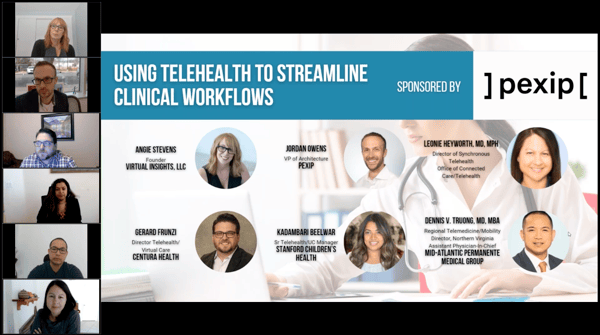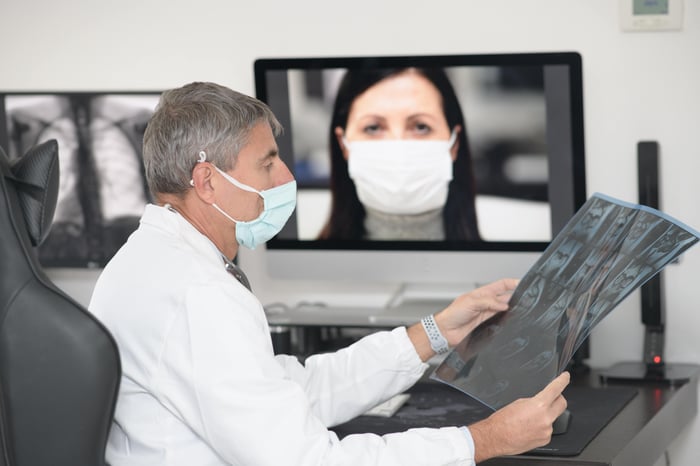When we speak about the benefits of telehealth, and specifically the video element within these services, focus is often placed on optimizing the patient experience. However, it’s just as important to consider how choosing the right video solution for your telehealth offering can optimize the internal tools and processes used by clinicians as well.
In this article, we explore how streamlining clinician workflows can lead to higher workplace satisfaction among providers, and ultimately, better patient outcomes. But how do we get there?
- The importance of technical integration
- Watch our panel discuss 'Using Telehealth to Streamline Clinical Workflows'
- Clinical perspectives: 8 point panel summary
- What have we learned about telehealth and what is the future of telehealth?
On February 26, 2021, I had the privilege of joining a panel at the Festival of Telehealth titled “Using Telehealth to Streamline Clinical Workflows.” The conversation included several doctors using Pexip-powered telehealth platforms from leading providers like the U.S. Department of Veterans Affairs (VA) and Kaiser Permanente, in addition to Stanford Children’s Health and Centura Health. Together, we discussed why integrations are so important, and how they work in practice.
During the panel, we discussed how, when the pandemic hit, clinicians began using any tool they could to continue providing care through video visits. The necessity for easy-to- join video visits, regardless of the device or location, grew exponentially overnight - in some cases as much as 1600%.
The problem is that these tools are often used outside of existing applications, making workflows complicated and disjointed, and adding technological hurdles to an already difficult time. Here, I’ll summarize some of the topics we discussed, including what an integrated telehealth system looks like, and the importance of prioritizing the clinician’s user experience when considering your options for video-based telehealth.
The importance of technical integration - and what that means for clinicians
When we think about the idea of integration from a video conferencing industry perspective, we often take a technical view, asking: what protocols, video layouts, video resolutions, and audio protocols are supported? But it’s important to remember the whole reason that we build and offer integrations: to improve the human experience of using technology in a very real and tangible way.
There are many reasons to prioritize integrations in the context of telehealth. We do integrations to streamline the patient experience. As the person receiving medical support and treatment, we want their experience to be easy, comfortable, and successful.
But there are many others whose experience is just as important. Integrations help the provider experience so that doctors and other care providers can access video visits quickly and in a way that’s organized within the other tools they use throughout their workday. We also integrate with standard business tools to help make the job of running a healthcare company easier. And administrators can benefit from the easy-to-use single pane of glass management interface that we provide and which can also be integrated in with other support and monitoring tools. Somebody needs to support, operate, and run these systems, because when something goes wrong, and sometimes it does, it needs to be fixed, and fixed urgently. In the context of telemedicine, our technology is the gateway to providing care for people who are often in difficult or sensitive situations.
Watch the panel now: “Using Telehealth to Streamline Clinical Workflows”
Streamlining workflows: insight from the clinical perspective
Most telehealth solutions use a combination of digital tools in their offering, including electronic health records (EHRs), scheduling calendars, apps, portals, peripherals, inpatient systems, and video conferencing. Pexip is a “behind the scenes” technology that brings all of these tools together by seamlessly integrating video with existing workflows and platforms like Microsoft Teams, Zoom, and EHRs like Epic. We are the backbone of the video visit technology for the U.S. Department of Veterans Affairs, Amwell, and Ontario Health.

In our panel discussion, clinical telehealth leaders from these organizations weighed in on how their teams use Pexip integrations to streamline their workflows. Here’s a summary of their insights and experiences:
- When applying telehealth integrations, it’s important to start by thinking first about your people, then your processes, and then the technology. You should find a technology that fits your existing workflows, rather than forcing people to adapt to the technology.
- Focus on outcomes rather than activity. In other words, what are the problems you’re trying to solve?
- Integrating your processes to support your workflows will help drive adoption across your organization.
- Integration can take time. Start with the end vision in mind, and work your way toward that.
- Find a solution that fits a large variety of use cases, from day-to-day virtual visits, to more specific and unique situations. And make sure that the platform has the ability to be further customized or integrated for the outcomes that you don’t yet foresee.
- Your solution should be agile enough to shift to all-virtual work if and when you need to. Covid-19 has taught us to be prepared for unforeseen disruptions to the ability to provide in-person care.
- Your video platform should allow for scalable integrations. The goal should be to provide a seamless, meaningful interaction that takes the burden off of busy, sometimes overwhelmed providers and allows them to join video visits and internal video interactions with just one click.
- Integration should be seen as a tool to provide information and communication when and where it’s needed. Whether that’s reminding a doctor of an upcoming virtual visit, or teaching the patient how to use the service, or allowing them to easily provide feedback about the visit, it’s about not only optimizing that one-hour video visit, but also everything that happens before, after, and around it.

What we’ve learned about telehealth, and where we’re headed
Integration is an iterative process. It’s a constant job which needs to continuously be improved and re-evaluated, making the feedback channel from clinicians and administrators a key element to creating a successful service. Something we at Pexip are always considering is how we can receive instant feedback on the success or failures of a video visit, so that we can adjust the experience and improve the value of the service for all our end users. When we look at technical integrations from a product perspective, we’re constantly reminding ourselves to consider the human aspect of the product we’re creating.
As much as we’ve learned over the past year about telehealth, both how it can succeed and how it can fail, we’re still discovering the full potential of this powerful technology. For patients, telehealth that’s integrated and flexible is making healthcare more equitable by helping more people receive care, regardless of the device or infrastructure they’re using. But a simple, accessible patient experience can only be realized if the teams providing telehealth services have their workflows integrated and optimized for the future of telehealth.
Watch the full panel discussion “Using Telehealth to Streamline Clinical Workflows” here.
If you’re ready to learn more about how Pexip seamlessly integrates with Epic and other telehealth solutions, visit our Pexip Health page.
- Healthcare
- Video Platform





